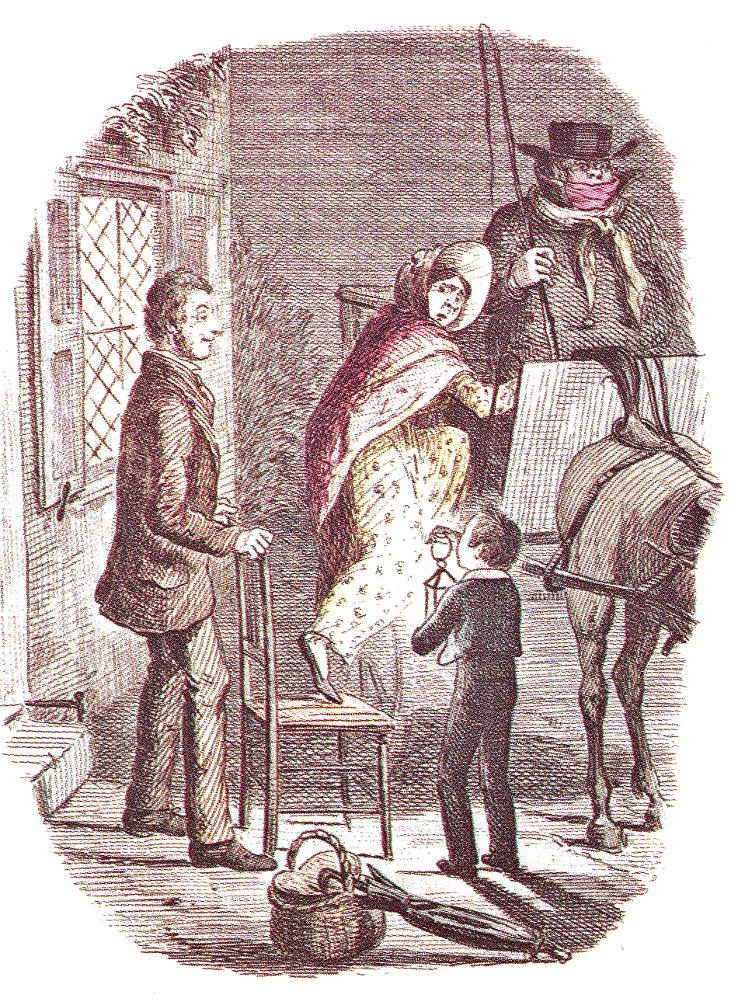Mr. Pumblechook
c. 1900
J. Clayton Clarke ("Kyd")
Watercolour
4.2 x 3 inches (10.5 cm high by 7.6 cm wide)
Dickens's Great Expectations, Garnett edition.
Another plate by the same artist
[Illustrations of this novel by other artists]
Scanned image and text by George P. Landow, with images and text below added by Philip V. Allingham. [Click on all the images to enlarge them, and mouse over the text for links.]
[You may use this image and those below without prior permission for any scholarly or educational purpose as long as you (1) credit the person who scanned the image and (2) link your document to this URL in a web document or cite the Victorian Web in a print one.
Passage Illustrated: Pip's Recollection of Seed Merchant "Uncle" Pumblechook
Mr. Pumblechook’s premises in the High Street of the market town, were of a peppercorny and farinaceous character, as the premises of a cornchandler and seedsman should be. It appeared to me that he must be a very happy man indeed, to have so many little drawers in his shop; and I wondered when I peeped into one or two on the lower tiers, and saw the tied-up brown paper packets inside, whether the flower-seeds and bulbs ever wanted of a fine day to break out of those jails, and bloom.
It was in the early morning after my arrival that I entertained this speculation. On the previous night, I had been sent straight to bed in an attic with a sloping roof, which was so low in the corner where the bedstead was, that I calculated the tiles as being within a foot of my eyebrows. In the same early morning, I discovered a singular affinity between seeds and corduroys. Mr. Pumblechook wore corduroys, and so did his shopman; and somehow, there was a general air and flavour about the corduroys, so much in the nature of seeds, and a general air and flavour about the seeds, so much in the nature of corduroys, that I hardly knew which was which. The same opportunity served me for noticing that Mr. Pumblechook appeared to conduct his business by looking across the street at the saddler, who appeared to transact his business by keeping his eye on the coachmaker, who appeared to get on in life by putting his hands in his pockets and contemplating the baker, who in his turn folded his arms and stared at the grocer, who stood at his door and yawned at the chemist. The watchmaker, always poring over a little desk with a magnifying-glass at his eye, and always inspected by a group of smock-frocks poring over him through the glass of his shop-window, seemed to be about the only person in the High Street whose trade engaged his attention. [Chapter 8, The Household Edition, pp. 24-25]
Social-climbing Mrs. Joe Appropriates Joe's Uncle, the Prosperous Mr. Pumblechook
Despite his comic pomposity, the odious Mr. Pumblechook has not been a favourite with Dickens’s illustrators. Even in a series as long as F. A. Fraser’s for the Household Edition, the prosperous, middle-aged seedsman from the town's High Street does not make a single appearance, nor does Marcus Stone in the initial illustrated edition of 1862 include a portrait of him. Although he appears at the Gargery Christmas dinner in Chapter 4, carrying a bottle of sherry and another of port for the festivities, there he arrives in civilian garb. Thus, Kyd’s image captures the essence of Joe’s uncle (appropriated by Mrs. Joe) in his shop, rather than dressed for visiting on his Shay-cart. He is a prosperous corn-chandler who is connected to such upper-class [Rochester] citizens as Miss Havisham. David Paroissien identifies his shop as modelled on the business frontage of “John Bye Fairborn, a corn-chandler and seedsman in Rochester High Street in the 1860s” (87).
Relevant Images of Pip, Joe, Pumblechook, and Mrs. Joe from Other Editions (1861-1910)




Left: John Mclenan's serial illustrations involving "Uncle Pumblechook": "Leave this lad to me, Ma'am; leave this lad to me." (29 December 1860). Left of centre: In the 1885 Kerslake & Robson Edition Pailthorpe introduces Pip's visit to Satis House with the delivery of the invitation to "play": Mrs. Joe returning from an Expedition in the the caricatural style of George Cruikshank. Centre: H. M. Brock's study of Pip and his family: And then they both stared at me (1910). Right: Harry Furniss's study of Pip's being the regular butt and victim of Mrs. Joe's oppression: Pip does not enjoy his Christmas dinner (1910).
Related Material
- Dickens's Great Expectations in Film and Television, 1917-2000
- Charles Dickens’s Great Expectations
- Bibliography of works relevant to illustrations of Great Expectations
Bibliography
Allingham, Philip V. "The Illustrations for Great Expectations in Harper's Weekly (1860-61) and in the Illustrated Library Edition (1862) — 'Reading by the Light of Illustration'." Dickens Studies Annual, Vol. 40 (2009): 113-169.
Dickens, Charles. Great Expectations. Harper's Weekly: A Journal of Civilization. Illustrated by John McLenan. Vol. IV.
______. ("Boz."). Great Expectations. With thirty-four illustrations from original designs by John McLenan. Philadelphia: T. B. Peterson (by agreement with Harper & Bros., New York), 1861.
______. Great Expectations. Illustrated by F. A. Fraser. The Household Edition. 22 volumes. London: Chapman and Hall,1876. Vo1. 11.
______. Great Expectations. Volume 19 of the Edition de Grande Luxe. Ed. Richard Garnett. London: Merrill and Baker, 1900.
Paroissien, David. The Companion to "Great Expectations." Westport, Conn.: Greenwood, 2000.
Victorian
Web
Illus-
tration
Charles
Dickens
Kyd
Next
Created 9 February 2007
Last modified 29 June 2025
